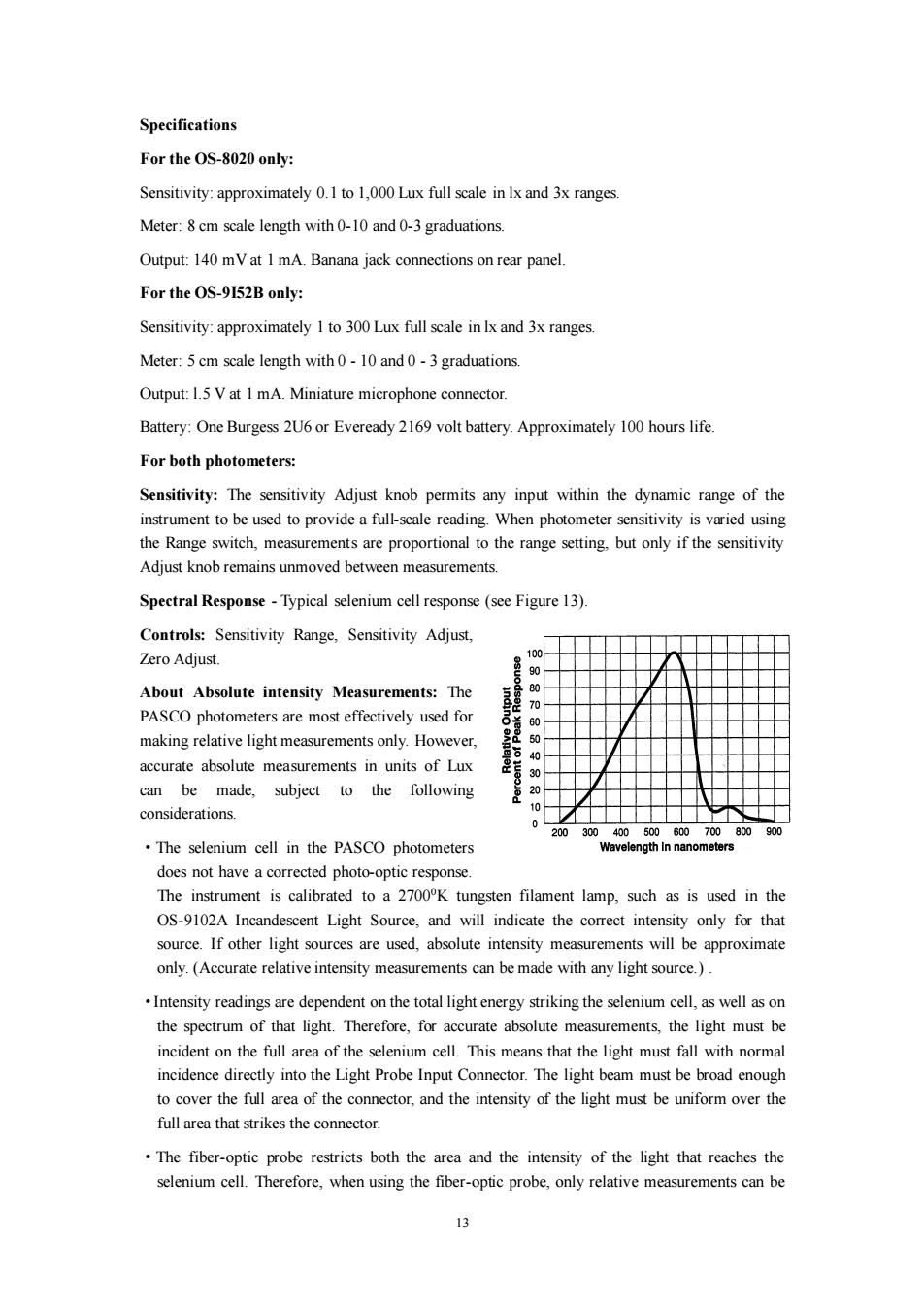正在加载图片...

Specifications For the OS-8020 only: Sensitivity:approximately 0.1 to 1,000 Lux full scale in Ix and 3x ranges. Meter:8 cm scale length with 0-10 and 0-3 graduations Output:140 mV at 1 mA.Banana jack connections on rear panel. For the OS-9152B only: Sensitivity:approximately I to 300 Lux full scale in Ix and 3x ranges. Meter:5 cm scale length with 0-10 and 0-3 graduations. Output:1.5 V at 1 mA.Miniature microphone connector. Battery:One Burgess 2U6 or Eveready 2169 volt battery.Approximately 100 hours life. For both photometers: Sensitivity:The sensitivity Adjust knob permits any input within the dynamic range of the instrument to be used to provide a full-scale reading.When photometer sensitivity is varied using the Range switch,measurements are proportional to the range setting,but only if the sensitivity Adjust knob remains unmoved between measurements. Spectral Response-Typical selenium cell response(see Figure 13). Controls:Sensitivity Range,Sensitivity Adjust, Zero Adjust. 100 About Absolute intensity Measurements:The 80 70 PASCO photometers are most effectively used for 60 making relative light measurements only.However. 50 accurate absolute measurements in units of Lux 40 30 can be made,subject to the following considerations. 0 200300400500600700800900 The selenium cell in the PASCO photometers Wavelength In nanometers does not have a corrected photo-optic response. The instrument is calibrated to a 2700K tungsten filament lamp,such as is used in the OS-9102A Incandescent Light Source,and will indicate the correct intensity only for that source.If other light sources are used,absolute intensity measurements will be approximate only.(Accurate relative intensity measurements can be made with any light source.). Intensity readings are dependent on the total light energy striking the selenium cell,as well as on the spectrum of that light.Therefore,for accurate absolute measurements,the light must be incident on the full area of the selenium cell.This means that the light must fall with normal incidence directly into the Light Probe Input Connector.The light beam must be broad enough to cover the full area of the connector,and the intensity of the light must be uniform over the full area that strikes the connector. The fiber-optic probe restricts both the area and the intensity of the light that reaches the selenium cell.Therefore,when using the fiber-optic probe,only relative measurements can be 313 Specifications For the OS-8020 only: Sensitivity: approximately 0.1 to 1,000 Lux full scale in lx and 3x ranges. Meter: 8 cm scale length with 0-10 and 0-3 graduations. Output: 140 mV at 1 mA. Banana jack connections on rear panel. For the OS-9I52B only: Sensitivity: approximately 1 to 300 Lux full scale in lx and 3x ranges. Meter: 5 cm scale length with 0 - 10 and 0 - 3 graduations. Output: l.5 V at 1 mA. Miniature microphone connector. Battery: One Burgess 2U6 or Eveready 2169 volt battery. Approximately 100 hours life. For both photometers: Sensitivity: The sensitivity Adjust knob permits any input within the dynamic range of the instrument to be used to provide a full-scale reading. When photometer sensitivity is varied using the Range switch, measurements are proportional to the range setting, but only if the sensitivity Adjust knob remains unmoved between measurements. Spectral Response - Typical selenium cell response (see Figure 13). Controls: Sensitivity Range, Sensitivity Adjust, Zero Adjust. About Absolute intensity Measurements: The PASCO photometers are most effectively used for making relative light measurements only. However, accurate absolute measurements in units of Lux can be made, subject to the following considerations. ·The selenium cell in the PASCO photometers does not have a corrected photo-optic response. The instrument is calibrated to a 27000K tungsten filament lamp, such as is used in the OS-9102A Incandescent Light Source, and will indicate the correct intensity only for that source. If other light sources are used, absolute intensity measurements will be approximate only. (Accurate relative intensity measurements can be made with any light source.) . ·Intensity readings are dependent on the total light energy striking the selenium cell, as well as on the spectrum of that light. Therefore, for accurate absolute measurements, the light must be incident on the full area of the selenium cell. This means that the light must fall with normal incidence directly into the Light Probe Input Connector. The light beam must be broad enough to cover the full area of the connector, and the intensity of the light must be uniform over the full area that strikes the connector. ·The fiber-optic probe restricts both the area and the intensity of the light that reaches the selenium cell. Therefore, when using the fiber-optic probe, only relative measurements can be